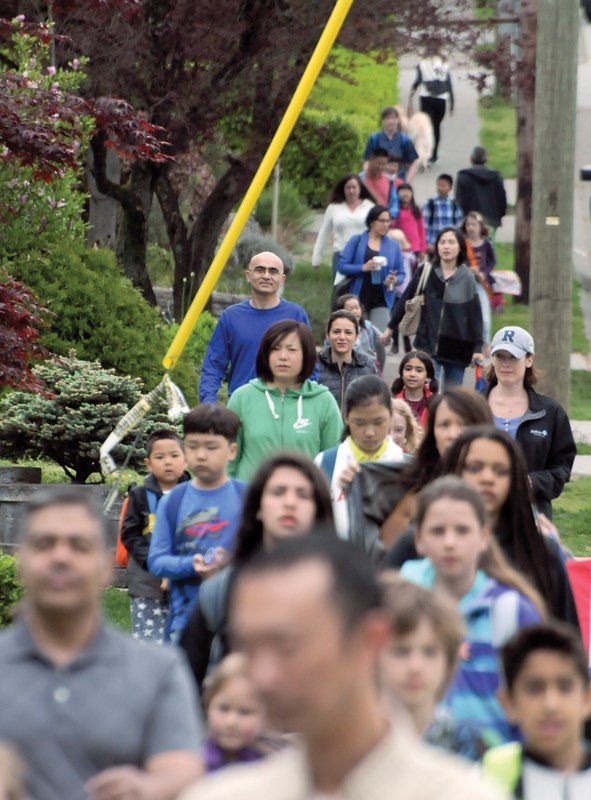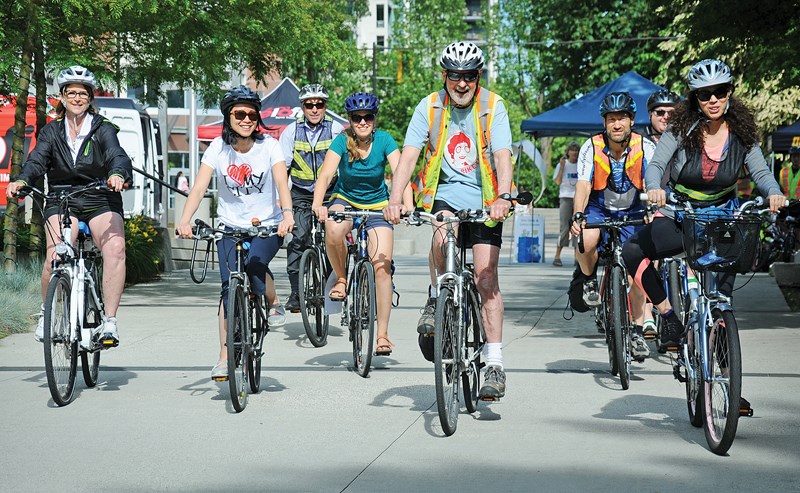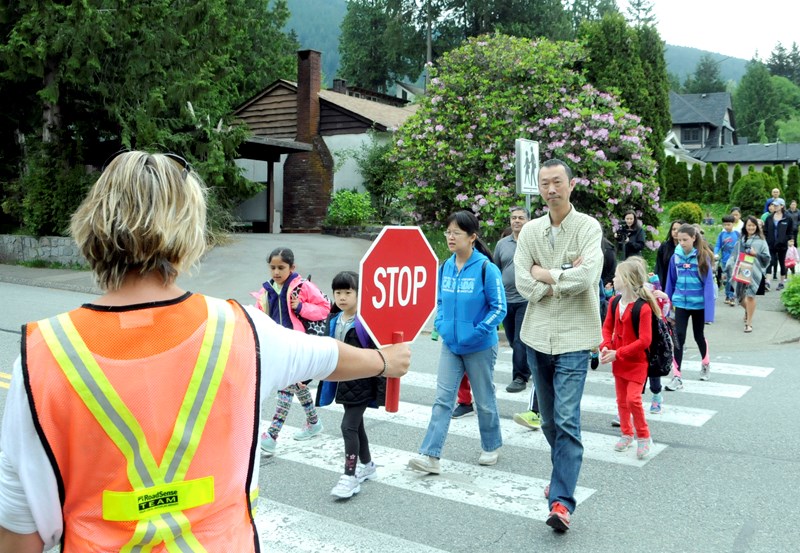On a sleepy Friday morning in late April, a small revolution takes place outside Canyon Heights elementary.
At first, there’s just the occasional SUV sidling up to the school, dropping kids off and then beelining to the Lions Gate Bridge.
Then, as 8:30 a.m. approaches, most of the vehicles are gone and it starts to look more like a parade. Hundreds of kids and parents, on foot and on bike, are streaming down Handsworth Road and Highland Boulevard. It’s got a festival-like atmosphere. There’s a DJ blasting the Proclaimers’ hit “I’m Gonna Be (500 Miles)” and some of the kids dance the Running Man. District of North Vancouver Mayor Richard Walton and Coun. Mathew Bond are there, mingling with the parents. The principal gives the crowd a pep talk and thanks everyone who came to school under their own steam. When the first bell rings, the party’s over and, whether they like it or not, the kids head inside to learn. Studies have found the ones who walked and biked will likely outperform their classmates who got a ride in the back of a car.
The Freedom Friday event tends to cause a spike in the number of kids who walk or bike to school. The event was put on by North Shore Safe Routes Advocates, a parent group that’s been front and centre in highlighting for local governments what they could be doing to make the commute to school a whole lot friendlier.
The number of people who use active transportation – getting around without the use of a car – has been on a steady decline for decades, which is manifesting itself in some pretty regrettable ways.
ParticipAction’s 2015 report card on children’s physical activity gave Canada’s kids a D-minus for the third consecutive year.
Fifty-eight per cent of today’s parents walked to school when they were kids. Only 28 per cent of their kids walk today.
And a 2015 study by the Provincial Health Services Authority estimated physical inactivity and excess weight were costing the province $3.6 billion in direct and indirect health care, disability and premature death costs.
But the tide may be beginning to turn, as grassroots initiatives like Freedom Friday, or a host of other similar themed events begin to spread. It’s part of a growing movement that’s getting more people to embrace active transportation.
Oddly, the school districts themselves have had a hand in contributing to the decline, as they have set up speciality academies, French Immersion, and international baccalaureate schools, said Carol Sartor, a safe route advocate and school travel planner with HASTe.
“No longer do we have our neighbourhood school,” she said. “What happens is those schools are no longer in perceived walking distance. ... Parents then drive their kids to these schools so they can get the education their parents have chosen for them.”
And because the school district allows parents to pick and choose where their kids will go to class, they often opt for ones that have more to do with their commute than what the school offers, Sartor said.
But even more important in the decline of kids on foot has been the nagging but totally unfounded perception that it’s not safe for kids to walk.
“Something happened along the way where ‘stranger danger’ took over,” Sartor said.
The RCMP estimate the odds of a child being abducted by a stranger are about one in 14 million.
“It’s more likely they’ll get hit by lightning – three times – than be abducted,” Sartor said.
Recently there was a “stranger danger” incident near Canyon Heights that caused a panic, which spread virally on the social media pages of parents in the area. It turned out to be an innocent misunderstanding.
“In our minds, we think it’s a dangerous world but really it’s the safest that it’s ever been,” Sartor said.
More than keeping the kids in the car, Sartor worries it’s having more damaging impacts on their emotional and mental health.
“Our fear, we pass on to our kids. We see a lot of anxiety happening,” she said. “You’re telling them that their neighbourhood isn’t safe.”

Good habits, much like bad ones, tend to form early. With that in mind, the North Vancouver school district offers resources to parents on how they too can co-ordinate Freedom Friday-like events or any other measure that will get more kids and parents to embrace active transportation.
“Our hope is, if you get those people young enough, you can set those lifestyle choices so we won’t have to be changing bad habits because that’s much more difficult. If we can get kids walking and being able to get around, then our future will be a lot brighter for commuting and it will reduce the congestion that we have within the North Shore,” Sartor said.
While much of HASTe and Safe Routes Advocates’ work is focused on kids, the exact same principles apply to adults. If we can break some old car-centric habits, we’ll likely have a higher quality of life, author and urbanist Charles Montgomery argues. It’s the entire thesis of his 2013 book Happy City.
“We know from our work that when people walk or bike or even take the bus, they report being happier with their entire lives,” he said.
Montgomery is giving a talk on the subject at Kay Meek Centre on June 21. It’s an area that’s ripe for hearing the message because as a municipality, the District of West Vancouver has its work cut out for it, he said.
“It’s a real shame. In my opinion, it’s more than just a health concern, it’s a human rights concern because everybody should have the right to move freely through the city and in some places in West Van, you can’t. Why? Because the pedestrian infrastructure isn’t great. Some of the streets on slopes don’t even have sidewalks. Cars are moving quickly and the crossing infrastructure isn’t good enough,” he said.
But even in West Van, where changes are most resisted by community members, Sartor said, things are starting to turn around. Two parent groups have arisen in Eagle Harbour and Westmount to lobby for safer school routes. Lead the Way, a group of West Bay elementary parents, formed after an incident last year in which a driver hit and seriously injured a dog as she and her young handler were crossing in a marked crosswalk.
In response, the school arranged for bright yellow flags to be placed at the crosswalk for students to hold and wave as they cross Mathers Avenue. There is a contingent in the active transportation world, however, who view this as a misstep because it puts the onus on the pedestrian to be seen, rather than on the driver who ought to be responsible for making sure the crosswalk is clear before proceeding.
“Blaming the victim is how it gets looked at,” Sartor said, although she is grateful for any improvement that is offered. “Getting infrastructure changed takes time but right now we’re in a crisis situation.”
Infrastructure is also a difference maker when it comes to cycling and, arguably, we have been on the wrong path for much of the last four decades. According to the 2011 national household survey, only one per cent of Canadian trips were made by bicycle, compared to more than a quarter in the Netherlands. John Forester, an early advocate of “vehicular cycling” in the 1960s and ’70s, firmly believed it was safest to ride mixed with traffic and actively fought against separated bike lanes in the name of safety.
“That philosophy permeated transportation engineering throughout North America and that explains the huge difference that happened between North America and Europe over the last 40 years,” said Kay Teschke, a professor in UBC’s school of population and public health.
While that may work for the real road warriors – the Lycra-clad, type-A personalities with bulging quads – it’s been a barrier to wider demographics.
Teschke recently presented her research on what types of bike routes are most attractive to cyclists, and which ones are least likely to result in injury to North Vancouver district council, which is reviewing its bicycle plan.
And much like the Europeans figured out 40 years ago, there’s safety in separation. On busy streets, physically separated bike lanes are the most likely to draw in new riders and they boast 90 per cent reduction in injury risk compared to a major city street with no bike infrastructure. Painted bike lanes, like the one on Lynn Valley Road, do little to entice riders or protect their safety. On residential streets, the most effective intervention is bike route designation with traffic control bollards at major arteries to prevent vehicles from making “rat runs” on quiet streets with bikes.
“When you start implementing this kind of thing, you start seeing changes in demographics of who cycles city streets to get to destinations. You start seeing women. You start seeing children,” Teschke said.
While district council was largely receptive to Teschke’s message, there was lingering trepidation about the inevitable political blowback bike lanes bring, something Teschke attempted to allay.
“There’s no question there’s a lot of loud voices against the bike infrastructure but when they’ve done polling, they’ve found the majorities are in favour so most people prefer this kind of thing.”
Montgomery agrees.
“In city after city after city, the story has been the same. People object to bike lanes. Separated bike lanes are brought in and suddenly people use them. They like them and local businesses are finding they do more trade,” he said, pointing to Vancouver as a prime example.
And some of the legislation meant to keep us safe may actually be having a counter-productive effect, Montgomery said.
“Guess what else is unhelpful. Mandatory helmet laws are dangerous. Why? Because they reduce the number of people who actually cycle and this has a greater impact on shortening life years than cyclists’ head injuries,” he said (although he wears a helmet and he advises other people to do the same.)
Most would argue streets are best designed by engineers, but in Montgomery’s opinion, it ought to be psychologists. As noted in Happy City, U.K. traffic psychologist Ian Walker conducted a study that found drivers give a wider berth to cyclists who are not wearing helmets, suggesting the sight of a helmet made them generally less careful. To further test the theory, Walker replicated the study wearing a long wig and found drivers gave an average of 14 centimetres more, if they believed the cyclist was a helmetless woman.
Though it’s not a competition, getting around the North Shore on foot or bike is a different experience depending on which municipality you’re in.
“You can tell when you cross a border. You don’t need a sign. I can tell you when I’m riding my bike or when I’m walking, the City of North Vancouver, their pedestrian and cyclist infrastructure is amazing and keeps getting built on,” Sartor said.
For all its praise, the city is still aggressively pursuing safer streets. In April, council voted to become a Vision Zero city, an international movement that aims to reduce deaths and serious injuries on the roads to zero by tailoring cities’ designs, laws and public outreach with safety in mind.
And according to data researched by Coun. Linda Buchanan, who introduced the plan to council, they’ve got a steep hill to climb.
“When you start to look at the data, it is significantly staggering the number of crashes that we witness,” she said noting, from 2009 to 2014, there were more than 41,000 crashes in North Vancouver alone. “And when you put pedestrians and cyclists into that, it’s significantly more.”
From 2013 to 2015, there were 300 serious crashes involving pedestrians and cyclists, two of them fatal.

“Really it’s about addressing vulnerability of people and our pedestrians are the most vulnerable,” she said. “People, regardless of their mode of travel, have responsibilities to ensure their safety and we can do it through education, we can do it through enforcement and we can do it through engineering.”
Following council’s unanimous decision to become a Vision Zero city, staff are expected to report back with an action plan in July.
Though North Van city and district and West Van have shown varying degrees of enthusiasm for encouraging walking and cycling, all three are on the right track when it comes to the big picture, Montgomery said.
“The best thing that any city can do, and that includes the three municipalities on the North Shore, is to build more walkable, connected, mixed-use places – more villages – so that people’s bike rides are short, their walks are short and so these places can support more frequent transit,” he said. “In cities around the world, decision-makers and citizens are waking up to the fact that connected, walkable, mixed-use places are healthier, happier, more fun and good for business.”



